warning PORSCHE 911 TURBO 2014 6.G Owners Manual
[x] Cancel search | Manufacturer: PORSCHE, Model Year: 2014, Model line: 911 TURBO, Model: PORSCHE 911 TURBO 2014 6.GPages: 300, PDF Size: 10.61 MB
Page 237 of 300
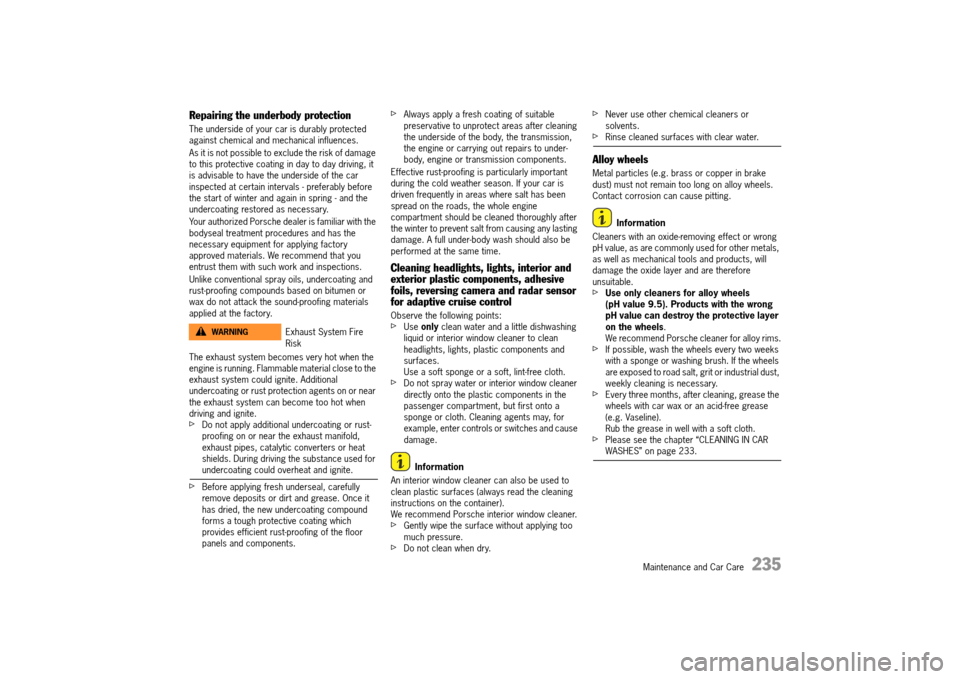
Maintenance and Car Care 235
Repairing the underbody protection
The underside of your car is durably protected against chemical and mechanical influences.
As it is not possible to exclude the risk of damage to this protective coating in day to day driving, it is advisable to have the underside of the car inspected at certain intervals - preferably before the start of winter and again in spring - and the undercoating restored as necessary.
Your authorized Porsche dealer is familiar with the bodyseal treatment procedures and has the necessary equipment for applying factory approved materials. We recommend that you entrust them with such work and inspections.
Unlike conventional spray oils, undercoating and rust-proofing compounds based on bitumen or wax do not attack the sound-proofing materials applied at the factory.
The exhaust system becomes very hot when the engine is running. Flammable material close to the exhaust system could ignite. Additional undercoating or rust protection agents on or near the exhaust system can become too hot when driving and ignite.fDo not apply additional undercoating or rust-proofing on or near the exhaust manifold, exhaust pipes, catalytic converters or heat shields. During driving the substance used for undercoating could overheat and ignite.
fBefore applying fresh underseal, carefully remove deposits or dirt and grease. Once it has dried, the new undercoating compound forms a tough protective coating which provides efficient rust-proofing of the floor panels and components.
fAlways apply a fresh coating of suitable preservative to unprotect areas after cleaning the underside of the body, the transmission, the engine or carrying out repairs to under-body, engine or transmission components.
Effective rust-proofing is particularly important during the cold weather season. If your car is driven frequently in areas where salt has been spread on the roads, the whole engine compartment should be cleaned thoroughly after the winter to prevent salt from causing any lasting damage. A full under-body wash should also be performed at the same time.
Cleaning headlights, lights, interior and exterior plastic components, adhesive foils, reversing camera and radar sensor for adaptive cruise control
Observe the following points: fUse only clean water and a little dishwashing liquid or interior window cleaner to clean headlights, lights, plastic components and surfaces.Use a soft sponge or a soft, lint-free cloth.fDo not spray water or interior window cleaner directly onto the plastic components in the passenger compartment, but first onto a sponge or cloth. Cleaning agents may, for example, enter controls or switches and cause damage.
Information
An interior window cleaner can also be used to clean plastic surfaces (always read the cleaning instructions on the container).We recommend Porsche interior window cleaner.fGently wipe the surface without applying too much pressure.fDo not clean when dry.
fNever use other chemical cleaners or solvents.fRinse cleaned surfaces with clear water.
Alloy wheels
Metal particles (e.g. brass or copper in brake dust) must not remain too long on alloy wheels.Contact corrosion can cause pitting.
Information
Cleaners with an oxide-removing effect or wrong pH value, as are commonly used for other metals, as well as mechanical tools and products, will damage the oxide layer and are therefore unsuitable.fUse only cleaners for alloy wheels (pH value 9.5). Products with the wrong pH value can destroy the protective layer on the wheels . We recommend Porsche cleaner for alloy rims.fIf possible, wash the wheels every two weeks with a sponge or washing brush. If the wheels are exposed to road salt, grit or industrial dust, weekly cleaning is necessary.fEvery three months, after cleaning, grease the wheels with car wax or an acid-free grease (e.g. Vaseline).Rub the grease in well with a soft cloth.fPlease see the chapter “CLEANING IN CAR WASHES” on page 233.
Exhaust System Fire Risk
WARNINGh
14_991_Turbo_21.book Seite 235 Mittwoch, 9. April 2014 2:19 14
Page 238 of 300
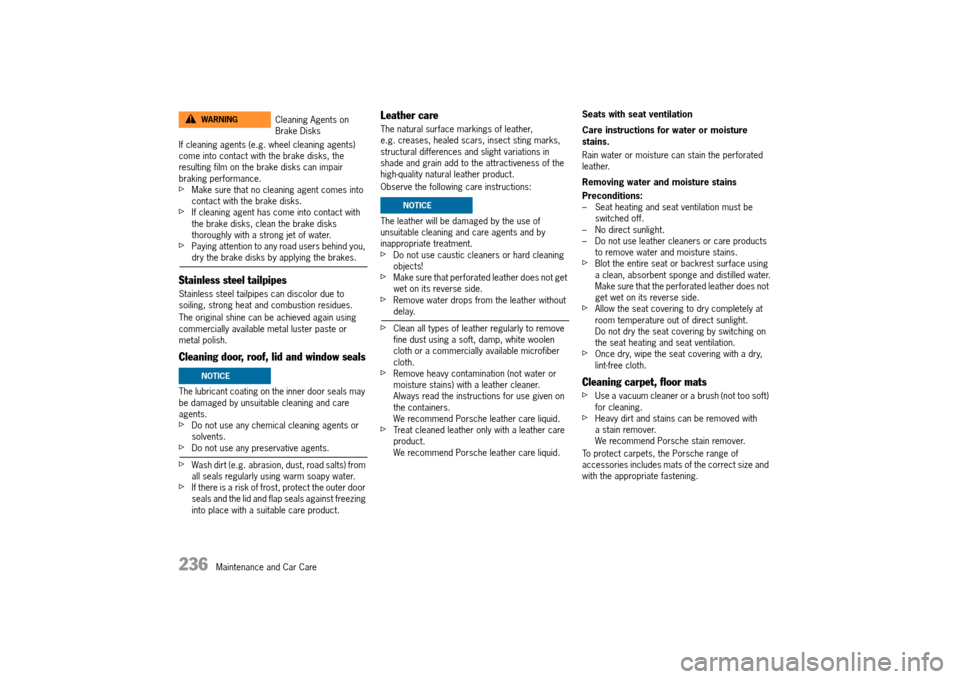
236 Maintenance and Car Care
If cleaning agents (e.g. wheel cleaning agents) come into contact with the brake disks, the resulting film on the brake disks can impair braking performance.fMake sure that no cleaning agent comes into contact with the brake disks.fIf cleaning agent has come into contact with the brake disks, clean the brake disks thoroughly with a strong jet of water.fPaying attention to any road users behind you, dry the brake disks by applying the brakes.
Stainless steel tailpipes
Stainless steel tailpipes can discolor due to soiling, strong heat and combustion residues.
The original shine can be achieved again using commercially available metal luster paste or metal polish.
Cleaning door, roof, lid and window seals
The lubricant coating on the inner door seals may be damaged by unsuitable cleaning and care agents.fDo not use any chemical cleaning agents or solvents.fDo not use any preservative agents.
fWash dirt (e.g. abrasion, dust, road salts) from all seals regularly using warm soapy water.fIf there is a risk of frost, protect the outer door seals and the lid and flap seals against freezing into place with a suitable care product.
Leather care
The natural surface markings of leather, e.g. creases, healed scars, insect sting marks, structural differences and slight variations in shade and grain add to the attractiveness of the high-quality natural leather product.
Observe the following care instructions:
The leather will be damaged by the use of unsuitable cleaning and care agents and by inappropriate treatment.fDo not use caustic cleaners or hard cleaning objects!fMake sure that perforated leather does not get wet on its reverse side.fRemove water drops from the leather without delay.
fClean all types of leather regularly to remove fine dust using a soft, damp, white woolen cloth or a commercially available microfiber cloth.fRemove heavy contamination (not water or moisture stains) with a leather cleaner.Always read the instructions for use given on the containers.We recommend Porsche leather care liquid.fTreat cleaned leather only with a leather care product.We recommend Porsche leather care liquid.
Seats with seat ventilation
Care instructions for water or moisture stains.
Rain water or moisture can stain the perforated leather.
Removing water and moisture stains
Preconditions: – Seat heating and seat ventilation must be switched off.– No direct sunlight.– Do not use leather cleaners or care products to remove water and moisture stains.fBlot the entire seat or backrest surface using a clean, absorbent sponge and distilled water.Make sure that the perforated leather does not get wet on its reverse side.fAllow the seat covering to dry completely at room temperature out of direct sunlight.Do not dry the seat covering by switching on the seat heating and seat ventilation.fOnce dry, wipe the seat covering with a dry, lint-free cloth.
Cleaning carpet, floor mats
fUse a vacuum cleaner or a brush (not too soft) for cleaning.fHeavy dirt and stains can be removed with a stain remover.We recommend Porsche stain remover.
To protect carpets, the Porsche range of accessories includes mats of the correct size and with the appropriate fastening.
Cleaning Agents on Brake Disks
WARNINGh
NOTICE
NOTICE
14_991_Turbo_21.book Seite 236 Mittwoch, 9. April 2014 2:19 14
Page 239 of 300
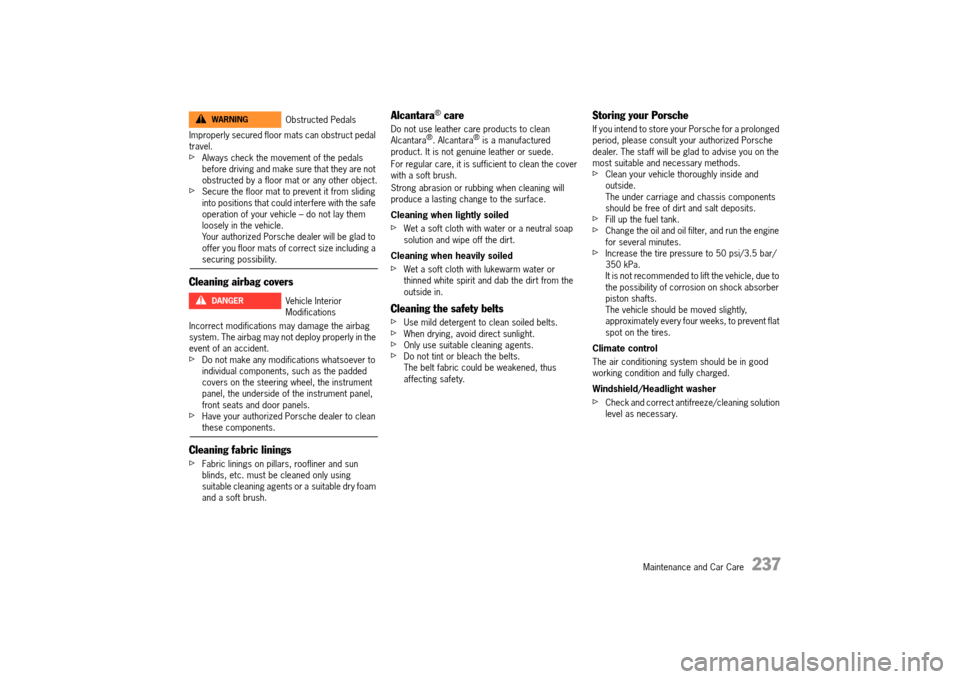
Maintenance and Car Care 237
Improperly secured floor mats can obstruct pedal travel.fAlways check the movement of the pedals before driving and make sure that they are not obstructed by a floor mat or any other object.fSecure the floor mat to prevent it from sliding into positions that could interfere with the safe operation of your vehicle – do not lay them loosely in the vehicle.Your authorized Porsche dealer will be glad to offer you floor mats of correct size including a securing possibility.
Cleaning airbag covers
Incorrect modifications may damage the airbag system. The airbag may not deploy properly in the event of an accident.fDo not make any modifications whatsoever to individual components, such as the padded covers on the steering wheel, the instrument panel, the underside of the instrument panel, front seats and door panels.fHave your authorized Porsche dealer to clean these components.
Cleaning fabric linings
fFabric linings on pillars, roofliner and sun blinds, etc. must be cleaned only using suitable cleaning agents or a suitable dry foam and a soft brush.
Alcantara® care
Do not use leather care products to clean Alcantara®. Alcantara® is a manufactured product. It is not genuine leather or suede.
For regular care, it is sufficient to clean the cover with a soft brush.
Strong abrasion or rubbing when cleaning will produce a lasting change to the surface.
Cleaning when lightly soiled
fWet a soft cloth with water or a neutral soap solution and wipe off the dirt.
Cleaning when heavily soiled
fWet a soft cloth with lukewarm water or thinned white spirit and dab the dirt from the outside in.
Cleaning the safety belts
fUse mild detergent to clean soiled belts.fWhen drying, avoid direct sunlight.fOnly use suitable cleaning agents.fDo not tint or bleach the belts.The belt fabric could be weakened, thus affecting safety.
Storing your Porsche
If you intend to store your Porsche for a prolonged period, please consult your authorized Porsche dealer. The staff will be glad to advise you on the most suitable and necessary methods. fClean your vehicle thoroughly inside and outside. The under carriage and chassis components should be free of dirt and salt deposits. fFill up the fuel tank. fChange the oil and oil filter, and run the engine for several minutes. fIncrease the tire pressure to 50 psi/3.5 bar/350 kPa.It is not recommended to lift the vehicle, due to the possibility of corrosion on shock absorber piston shafts.The vehicle should be moved slightly, approximately every four weeks, to prevent flat spot on the tires.
Climate control
The air conditioning system should be in good working condition and fully charged.
Windshield/Headlight washer
fCheck and correct antifreeze/cleaning solution level as necessary.
Obstructed Pedals
Vehicle Interior Modifications
WARNINGh
DANGERh
14_991_Turbo_21.book Seite 237 Mittwoch, 9. April 2014 2:19 14
Page 242 of 300
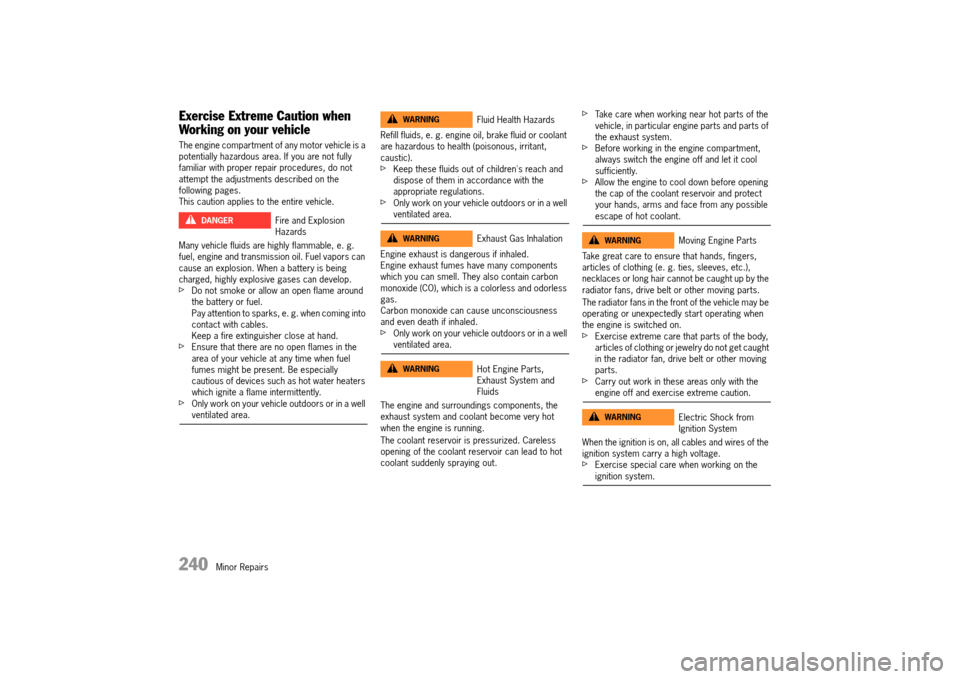
240 Minor Repairs
Exercise Extreme Caution when
Working on your vehicle
The engine compartment of any motor vehicle is a potentially hazardous area. If you are not fully familiar with proper repair procedures, do not attempt the adjustments described on the following pages.This caution applies to the entire vehicle.
Many vehicle fluids are highly flammable, e. g. fuel, engine and transmission oil. Fuel vapors can cause an explosion. When a battery is being charged, highly explosive gases can develop.fDo not smoke or allow an open flame around the battery or fuel.Pay attention to sparks, e. g. when coming into contact with cables.Keep a fire extinguisher close at hand.fEnsure that there are no open flames in the area of your vehicle at any time when fuel fumes might be present. Be especially cautious of devices such as hot water heaters which ignite a flame intermittently.fOnly work on your vehicle outdoors or in a well ventilated area.
Refill fluids, e. g. engine oil, brake fluid or coolant are hazardous to health (poisonous, irritant, caustic).fKeep these fluids out of children's reach and dispose of them in accordance with the appropriate regulations.fOnly work on your vehicle outdoors or in a well ventilated area.
Engine exhaust is dangerous if inhaled. Engine exhaust fumes have many components which you can smell. They also contain carbon monoxide (CO), which is a colorless and odorless gas.Carbon monoxide can cause unconsciousness and even death if inhaled.fOnly work on your vehicle outdoors or in a well ventilated area.
The engine and surroundings components, the exhaust system and coolant become very hot when the engine is running.
The coolant reservoir is pressurized. Careless opening of the coolant reservoir can lead to hot coolant suddenly spraying out.
fTake care when working near hot parts of the vehicle, in particular engine parts and parts of the exhaust system.fBefore working in the engine compartment, always switch the engine off and let it cool sufficiently.fAllow the engine to cool down before opening the cap of the coolant reservoir and protect your hands, arms and face from any possible escape of hot coolant.
Take great care to ensure that hands, fingers, articles of clothing (e. g. ties, sleeves, etc.), necklaces or long hair cannot be caught up by the radiator fans, drive belt or other moving parts.
The radiator fans in the front of the vehicle may be operating or unexpectedly start operating when the engine is switched on.fExercise extreme care that parts of the body, articles of clothing or jewelry do not get caught in the radiator fan, drive belt or other moving parts.fCarry out work in these areas only with the engine off and exercise extreme caution.
When the ignition is on, all cables and wires of the ignition system carry a high voltage.fExercise special care when working on the ignition system.
Fire and Explosion Hazards
DANGERh
Fluid Health Hazards
Exhaust Gas Inhalation
Hot Engine Parts, Exhaust System and Fluids
WARNINGh
WARNINGh
WARNINGh
Moving Engine Parts
Electric Shock from Ignition System
WARNINGh
WARNINGh
14_991_Turbo_21.book Seite 240 Mittwoch, 9. April 2014 2:19 14
Page 243 of 300

Minor Repairs 241
If the vehicle is not secured, or incorrectly secured, during repair work, it could move unexpectedly or fall from the car jack or car lift.fBe alert and cautious around the engine at all times while it is running. If you have to work on the engine while it is running, always apply the electric parking brake and put the PDK selector lever in position P or N.fAlways support your car with safety stands if it is necessary to work under the car. The jack supplied with the car is not adequate for this purpose.Switch off level control of air suspension and height adjustment.Please see the chapter “RAISING THE VEHICLE WITH A LIFTING PLATFORM, TROLLEY JACK OR STANDARD JACK” on page 254.fJack up the vehicle only at the specified jacking points on the underside of the vehicle.fNever start the engine when the vehicle is jacked or lifted up. Vibration from the engine could cause the vehicle to fall.fWhen working under the car without safety stands but with the wheels on the ground, make sure the car is on level ground, the wheels are blocked, and that the engine cannot be started.Withdraw ignition keys (switch ignition off in vehicles that have Porsche Entry & Drive).
Information
fIncomplete or improper servicing may cause problems in the operation of the car. If in doubt about any servicing, have it done by your authorized Porsche dealer.Improper maintenance during the warranty period may affect your Porsche warranty coverage.fSome countries require additional tools and special spare parts to be carried in your vehicle. Please make enquiries before driving abroad.
T
The engine-compartment blowers are mounted under the engine compartment lid.After the engine is switched off, the engine compartment temperature is monitored for approx. 30 minutes.During this period, and depending on temperature, the engine-compartment blowers may continue to run or start to run.fCarry out work in this area only with the engine off and exercise extreme caution.
The radiators and radiator fans are in the front of the vehicle.The radiator fans in the front of the vehicle may be operating or unexpectedly start operating when the engine is switched on.fCarry out work in these areas only with the engine switched off.fTake great care to ensure that parts of the body, items of clothing or jewelery cannot be drawn in by the radiator fan, engine-compartment blower, drive belt or other moving parts.
Measurements on test stands
Performance test
Performance tests on roller-type test stands are not approved by Porsche.
Brake tests
Brake tests must be performed only on roller-type test stands.
The following limit values must not be exceeded on roller-type test stands: – Test speed 4.7 mph (7.5 km/h)– Test duration 20 seconds
Testing the electric parking brake
Electric parking brake tests on the brake test stand must only be performed with the ignition switched on and the Porsche Doppelkupplung selector lever in position N. The vehicle switches automatically to brake test stand mode, in which the electric parking brake can be tested.The message “ Electric parking brake in service mode ” appears on the multi-function display in the instrument panel.
Balancing wheels on the vehicle
During finish balancing of the wheels, the entire vehicle must be lifted and the wheels must be free to turn.
Information
The tools required for changing a wheel (e.g. jack, wheel bolt wrench, assembly aids) are not supplied as standard with the vehicle. Your authorized Porsche dealer will be pleased to advise you.
Failure to Secure VehicleWARNINGh
Radiator Fans, Engine Compartment Blowers
WARNINGh
14_991_Turbo_21.book Seite 241 Mittwoch, 9. April 2014 2:19 14
Page 244 of 300
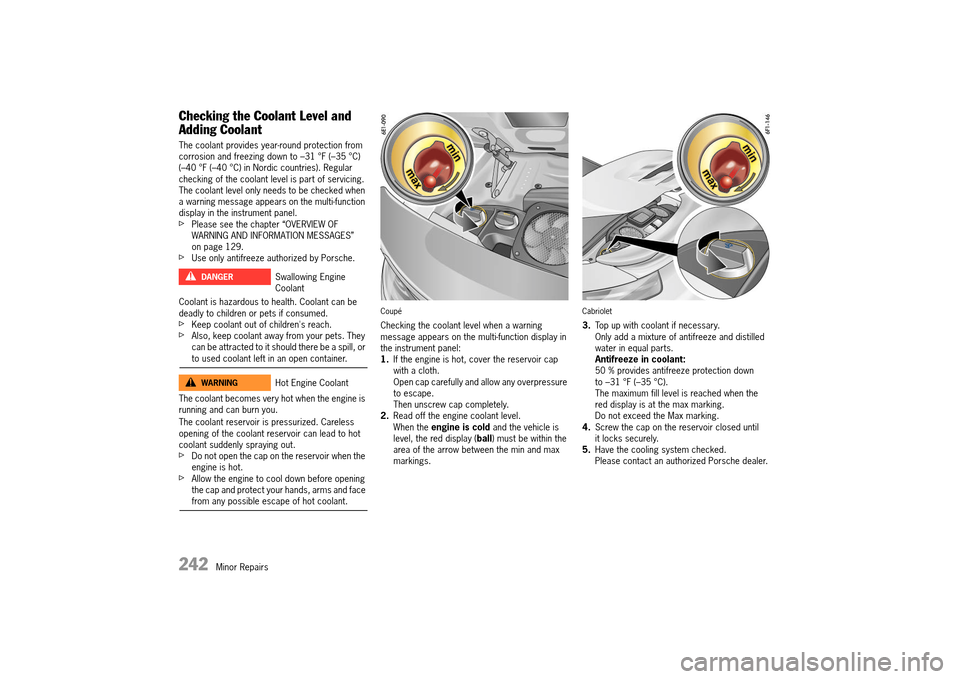
242 Minor Repairs
Checking the Coolant Level and
Adding Coolant
The coolant provides year-round protection from corrosion and freezing down to –31 °F (–35 °C)(–40 °F (–40 °C) in Nordic countries). Regular checking of the coolant level is part of servicing. The coolant level only needs to be checked when a warning message appears on the multi-function display in the instrument panel.fPlease see the chapter “OVERVIEW OF WARNING AND INFORMATION MESSAGES” on page 129.fUse only antifreeze authorized by Porsche.
Coolant is hazardous to health. Coolant can be deadly to children or pets if consumed.fKeep coolant out of children's reach.fAlso, keep coolant away from your pets. They can be attracted to it should there be a spill, or to used coolant left in an open container.
The coolant becomes very hot when the engine is running and can burn you.
The coolant reservoir is pressurized. Careless opening of the coolant reservoir can lead to hot coolant suddenly spraying out.fDo not open the cap on the reservoir when the engine is hot.fAllow the engine to cool down before opening the cap and protect your hands, arms and face from any possible escape of hot coolant.
Coupé
Checking the coolant level when a warning message appears on the multi-function display in the instrument panel:1. If the engine is hot, cover the reservoir cap with a cloth.Open cap carefully and allow any overpressure to escape.Then unscrew cap completely.2. Read off the engine coolant level. When the engine is cold and the vehicle is level, the red display ( ball) must be within the area of the arrow between the min and max markings.
Cabriolet
3. Top up with coolant if necessary. Only add a mixture of antifreeze and distilled water in equal parts.Antifreeze in coolant:50 % provides antifreeze protection down to –31 °F (–35 °C).The maximum fill level is reached when the red display is at the max marking.Do not exceed the Max marking.4. Screw the cap on the reservoir closed until it locks securely.5. Have the cooling system checked. Please contact an authorized Porsche dealer.
Swallowing Engine Coolant
Hot Engine Coolant
DANGERh
WARNINGh
14_991_Turbo_21.book Seite 242 Mittwoch, 9. April 2014 2:19 14
Page 245 of 300
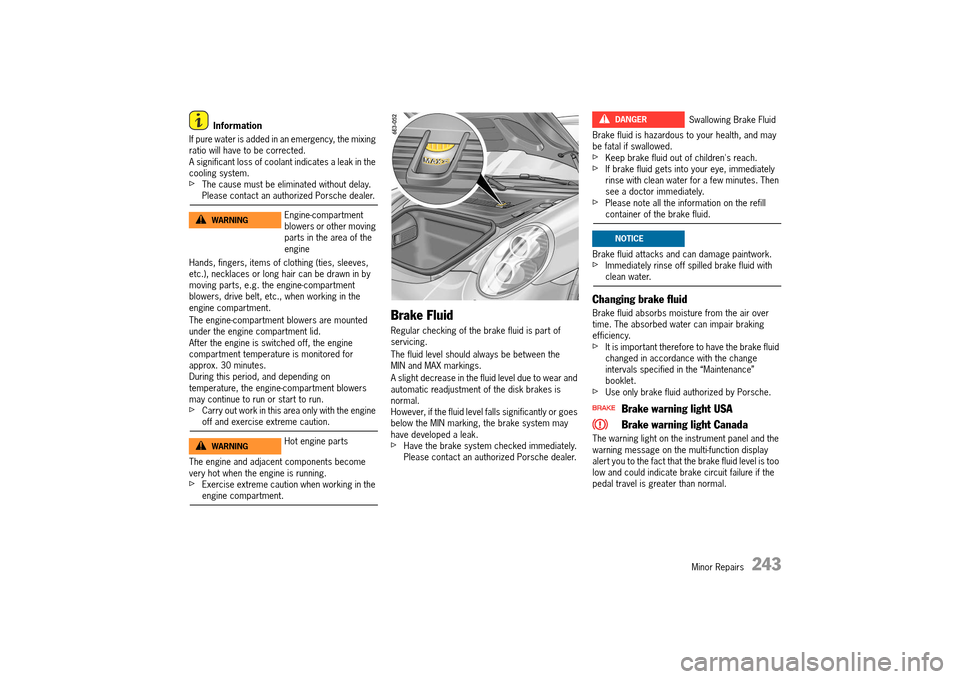
Minor Repairs 243
Information
If pure water is added in an emergency, the mixing ratio will have to be corrected.A significant loss of coolant indicates a leak in the cooling system.fThe cause must be eliminated without delay. Please contact an authorized Porsche dealer.
Hands, fingers, items of clothing (ties, sleeves, etc.), necklaces or long hair can be drawn in by moving parts, e.g. the engine-compartment blowers, drive belt, etc., when working in the engine compartment.
The engine-compartment blowers are mounted under the engine compartment lid.After the engine is switched off, the engine compartment temperature is monitored for approx. 30 minutes.During this period, and depending on temperature, the engine-compartment blowers may continue to run or start to run.fCarry out work in this area only with the engine off and exercise extreme caution.
The engine and adjacent components become very hot when the engine is running.fExercise extreme caution when working in the engine compartment.
Brake Fluid
Regular checking of the brake fluid is part of servicing.
The fluid level should always be between the MIN and MAX markings.
A slight decrease in the fluid level due to wear and automatic readjustment of the disk brakes is normal.However, if the fluid level falls significantly or goes below the MIN marking, the brake system may have developed a leak.fHave the brake system checked immediately. Please contact an authorized Porsche dealer.
Brake fluid is hazardous to your health, and may be fatal if swallowed.fKeep brake fluid out of children's reach.fIf brake fluid gets into your eye, immediately rinse with clean water for a few minutes. Then see a doctor immediately.fPlease note all the information on the refill container of the brake fluid.
Brake fluid attacks and can damage paintwork.fImmediately rinse off spilled brake fluid with clean water.
Changing brake fluid
Brake fluid absorbs moisture from the air over time. The absorbed water can impair braking efficiency.fIt is important therefore to have the brake fluid changed in accordance with the change intervals specified in the “Maintenance” booklet.fUse only brake fluid authorized by Porsche.
Brake warning light USA
Brake warning light Canada
The warning light on the instrument panel and the warning message on the multi-function display alert you to the fact that the brake fluid level is too low and could indicate brake circuit failure if the pedal travel is greater than normal.
Engine-compartment blowers or other moving parts in the area of the engine
Hot engine parts
WARNINGh
WARNINGh
Swallowing Brake FluidDANGERh
NOTICE
14_991_Turbo_21.book Seite 243 Mittwoch, 9. April 2014 2:19 14
Page 246 of 300

244 Minor Repairs
Information
If the warning light and warning message appear when driving: fStop immediately in a suitable place.fDo not continue driving.Please contact an authorized Porsche dealer.
For information on warning messages on the multi- function display: fPlease see the chapter “OVERVIEW OF WARNING AND INFORMATION MESSAGES” on page 129.
Electromechanical Power Steering
When the engine is stopped (e.g. when on tow), no power steering assistance is available.Increased force is required for steering.fExercise extreme care when your vehicle is being towed.fHave the fault corrected. Please contact an authorized Porsche dealer.
Changing Air Cleaner
Regular replacement of the filter element is part of servicing.fIn dusty conditions, clean the filter element more frequently and replace it if necessary.fPlease see the chapter “MEASUREMENTS ON TEST STANDS” on page 241.
Changing Particle Filters
Regular replacement of the filters is part of servicing.
Dirty filters can be the cause of reduced air throughput, e.g. the windows can mist up.fHave the filters replaced.Please contact an authorized Porsche dealer.
Information
The particle filters ensure that the fresh air entering the passenger compartment is virtually free of dust and pollen.fIf the outside air is polluted by exhaust fumes, press the recirculated-air button.
Tires and Wheels
The original equipment tires and wheel rims on your Porsche comply with all applicable Federal Motor Vehicle Safety Standards.
Information
The summer tires of your Sports Car have been specially developed and adapted for high performance.The tire characteristics change at low outside temperatures (below 15 °C).This can result in noises when parking or maneuvering at low outside temperatures.
For your safety remember the following:
– Wheel rims and wheel bolts are matched to fit your Porsche.– If you intend to use other than original equipment wheels, be sure that they conform to Porsche specifications for your model. Only tires with the same make and with the same specification code (e.g. “N0”, “N1”...) can be mounted.– The use of wheel rims and wheel bolts that do not meet specifications of the original factory installed equipment will affect the safe operation of your vehicle and affect warranty coverage.– Before you plan on exchanging wheels, or snow tires already mounted on the wheel rims, consult your authorized Porsche dealer. Your dealer has the technical information necessary to advise you which wheel rims and wheel bolts are compatible with the original factory installations.
No Power Steering AssistWARNINGh
14_991_Turbo_21.book Seite 244 Mittwoch, 9. April 2014 2:19 14
Page 248 of 300

246 Minor Repairs
The temperature grade for this tire is established for a tire that is properly inflated and not overloaded. Excessive speed, underinflation, or excessive loading, either separately or in combination, can cause heat buildup and possible tire failure.fDo not exceed the permitted maximum speed for the tires fitted to the vehicle.fEnsure that the tires are set to the correct inflation pressure.fObserve the maximum load for the vehicle.
Tire pressures
Driving the vehicle with low tire pressure increases risk of a tire failure and resulting loss of control. Furthermore, low tire pressure increases rate of wear of the affected tires and causes damage. fAlways use an accurate tire pressure gauge when checking inflation pressures.fDo not exceed the maximum tire pressure listed on the tire sidewall. (Also refer to “Technical data”).fPlease see the chapter “TIRE PRESSURE PLATE” on page 247.fCold tire inflation pressure means: all tires must be cold, ambient temperature maximum 68 °F (20 °C), when adjusting the inflation pressure. Avoid sunlight striking the tires before measuring cold pressures, since the pressures would rise from temperature influence.fValve caps protect the valve from dust and dirt, and thus from leakage. Always screw caps tightly down. Replace missing caps immediately.
fUse only plastic valve caps.fFor safety reasons, don't use tire inflating bottles.
fPlease see the chapter “TIRE PRESSURE FOR COLD TIRES (68 °F/ 20 °C)” on page 287.
Each tire, including the spare (if provided), should be checked monthly when cold and inflated to the
inflation pressure recommended by the vehicle manufacturer on the vehicle placard or tire inflation pressure label. (If your vehicle has tires of
a different size than the size indicated on the vehicle placard or tire inflation pressure label, you
should determine the proper tire inflation pressure
for those tires.)
As an added safety feature, your vehicle has been equipped with a Tire Pressure Monitoring System (TPMS) that illuminates a low tire pressure telltale when one or more of your tires is significantly under-inflated. Accordingly, when the low tire pressure telltale illuminates, you should stop and check your tires as soon as possible, and inflate them to the proper pressure. Driving on a significantly under-inflated tire causes the tire to overheat and can lead to tire failure. Under-inflation also reduces fuel efficiency and tire tread life, and may affect the vehicle’s handling and stopping ability.
Please note that the TPMS is not a substitute for proper tire maintenance, and it is the driver’s responsibility to maintain correct tire pressure, even if under-inflation has not reached the level to trigger illumination of the TPMS low tire pressure tell-tale.
For further information on the tire pressure monitoring:fPlease see the chapter “TIRE PRESSURE MENU (TIRE PRESSURE MONITORING SYSTEM, TPMS)” on page 105.
When tires are warm, the tire pressure is increased.fNever let air out of hot tires. This could cause the tire pressure to fall below the prescribed value.
Insufficient tire pressure can cause tires to over- heat and thus be damaged – even invisibly. Hidden tire damage is not eliminated by subsequently correcting the tire pressure.
Overloading
Overloading can lead to dangerous vehicle reactions and long braking distances.fDo not overload your vehicle. Be careful about the roof load. fIf you plan to load the vehicle, first correct the tire pressure. Tire pressure for loaded vehicle can be found on the tire pressure plate and in the chapter technical data.fNever exceed the specified axle load.
Tire Abuse
Low Tire Pressure
WARNINGh
DANGERhOverloading TiresDANGERh
14_991_Turbo_21.book Seite 246 Mittwoch, 9. April 2014 2:19 14
Page 249 of 300

Minor Repairs 247
Risk of damage to the vehicle and to the tires.
Damage due to overloading is not covered by the vehicle warranty.
Tire damage may also be caused by overloading, and this damage is not covered by your tire warranty.fDo not overload your vehicle. Be careful about the roof load. fIf you plan to load the vehicle, first correct the tire pressure. Tire pressure for loaded vehicle can be found on the tire pressure plate and in the chapter technical data.fNever exceed the specified axle load.
fPlease see the chapter “LOADING INFORMATION” on page 204.
NOTICE
Example of a tire pressure plate
Tire Pressure plate
Information on the tire pressure plate
A Seating capacity
Maximum number of vehicle occupants, including the driver.B Vehicle load limit
Is the maximum total weight limit specified of the load (passengers and cargo) for the vehicle. This is the maximum weight of passengers and cargo that can be loaded into the vehicle. Please see the chapter “LOADING INFORMATION” on page 204.
C Original tire size
Size of tires mounted at the factory. D Recommended cold tire inflation pressure
These values are for cold tires (68 °F/20 °C).
Tire traction
When driving on wet or slushy roads, a wedge of water may build up between the tires and the road. This phenomenon is known as “hydroplane” and may cause partial or complete loss of traction, vehicle control or stopping ability.fReduce speed on wet surfaces.
HydroplaningWARNINGh
14_991_Turbo_21.book Seite 247 Mittwoch, 9. April 2014 2:19 14